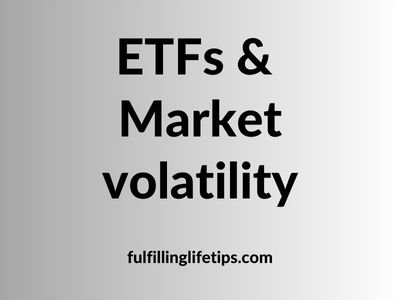In today’s fast-paced financial world, market volatility is an ever-present reality that investors must be prepared to navigate. Exchange-traded funds (ETFs) are a popular investment vehicle that offers investors a way to participate in the stock market while potentially mitigating some of the risks associated with market volatility.
In this article, we’ll explore the relationship between ETFs and market volatility, and provide some tips for managing your investments during tumultuous times.

Understanding ETFs
Before we dive into the relationship between ETFs and market volatility, let’s first define what ETFs are.
ETFs are investment funds that are traded on a stock exchange, much like individual stocks. They hold a basket of securities, such as stocks or bonds, and offer investors a low-cost way to diversify their portfolios. ETFs are bought and sold throughout the day, just like individual stocks, and their prices fluctuate based on supply and demand.
ETFs and Market Volatility
ETFs can offer investors a way to navigate market volatility because of their inherent diversification. Because ETFs hold a basket of securities, they are less susceptible to the risks associated with investing in individual stocks. This diversification can help mitigate some of the risks of market volatility.
Another advantage of ETFs during times of market volatility is that they can be bought and sold throughout the day at the market price on market exchanges. This can provide investors with more flexibility and control over their investments. For example, if an investor notices that a particular sector is experiencing a downturn, they can sell their ETFs that track that sector and reallocate their investments elsewhere.
Tips for Managing Your ETFs During Market Volatility
While ETFs can be a helpful tool for navigating market volatility, it’s important to approach your investments with a strategic mindset. Here are some tips for managing your ETFs during market volatility:
- Have a plan: Before investing in ETFs, it’s important to have a well-defined investment plan. This should include your investment objectives, risk tolerance, and a plan for how you’ll respond to market volatility.
- Monitor your investments: Keep an eye on the markets and be prepared to adjust your investments as needed. For example, if a particular sector is experiencing a downturn, consider selling your ETFs that track that sector and reallocating your investments elsewhere.
- Stay diversified: Diversification is key to mitigating the risks of market volatility. Make sure your portfolio includes a mix of different asset classes, such as stocks, bonds, and commodities.
- Consider using stop-loss orders: A stop-loss order is an order to sell a security when it reaches a certain price. This can help limit potential losses during times of market volatility.
- Be patient: Remember that market volatility is a normal part of investing. Avoid making emotional decisions and stick to your long-term investment plan.
Conclusion
Market volatility can be a daunting prospect for investors, but ETFs can offer a way to navigate the ups and downs of the market. By understanding how ETFs work and following some simple tips for managing your investments, you can potentially mitigate some of the risks associated with market volatility and stay on track toward your long-term investment objectives.




